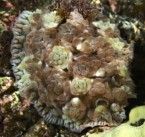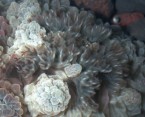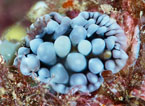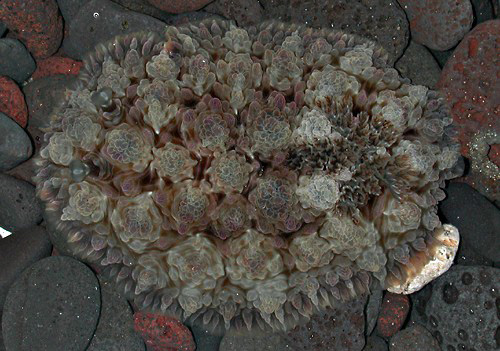| Home |
| Acknowledgments |
| Conventions |
| Glossary |
| Maps |
| References |
| Links |
| Articles |
| Thumbnails |
| Species
list |
| Family |
| Next
species |
Additional Photos

side, pale

underside, typical

underside, atypical

tall tubercles

low tubercles

branchia

rhinophores

tubercle detail

young

with shrimp
_______________
GALLERY

Dendrodoris tuberculosa (Quoy & Gaimard, 1832)

| Maximum size: about 200 mm. Identification: This is a broad, moderately firm species with closely spaced clusters of elaborate tubercles on its notum. The sides of the central tubercle in each cluster are usually covered by multiple rings of smaller tubercles. The height of the secondary tubercles is variable. Its body ranges from cream to pale rose and lighter bands radiate from the tubercles to the margin of the notum. Dark brown patches may be present between the tubercles but they are usually less extensive than in Dendrodoris carbunculosa. It may be distinguished from D. carbunculosa by its translucent notum, more elaborate tubercles and the prominent white spots on the underside of most animals. (Note 1) In photos taken with a flash, it often appears to have light lines running along the crests formed by the rings of smaller tubercles. (Note 2). Natural history: Dendrodoris tuberculosa is a moderately common species found in moderately protected to moderately exposed rocky habitats at depths of < 1 to 26 m (< 3 to 85 ft). It lays a cream egg mass with a frilly margin. (Kay & Young, 1969) Occasionally, it may host the commensal shrimp, Zenopontonia rex (= Periclimenes imperator). (see photo) Distribution: Big Island, Maui, Lanai, Molokai, Oahu, Kauai and Niihau: widely distributed in the Indo-Pacific. Taxonomic notes: This species is referred to as the "tuberculous nudibranch" in Hoover, 1998 & 2006. It may have been first reported from Hawaii in Kay & Young, 1969 assuming that Doris rugosa Pease, 1860 is actually a synonym of D. carbunculosa, contra the suggestion in Kay, 1979. The first photo in Bertsch and Johnson, 1981 is actually of D. carbunculosa, instead. (Note 3)(Note 4) Photo: CP: 120 mm: Hekili Point, Maui; Nov. 4, 2002. Observations and comments: Note 1: A large animal found at Kapalua Bay on April 11, 2019 had elaborate tubercles, marginal folds extending to the edge of the notum, a brown underside and "refraction lines" when photographed but lacked spots on its underside. Occasional animals found elsewhere in the Indo-Pacific also share that combination of traits. So, although all known D. carbunculosa lack such spots, not all D. tuberculosa have them. (see photos) Note 2: Perhaps, the translucent tissue of the notum acts as a lens, focusing the refracted light of the flash in such a way that it is concentrated along the crests? The lines are generally not visible to the eye. Note 3: There's some chance that a third, cryptic species may be complicating the separation of D. tuberculosa and D. carbunculosa. If animals labelled as "tall tubercles" consistently lack spots on the underside that might suggest a further split. Note 4: An animal with unusually low tubercles and pale tubercle tips found by Lloyd Johnson in 2022 is atypical for Hawaii but reminiscent of some animals found elsewhere (such as the 5th photo in Gosliner, et. al. (2018)). It could be a diseased animal. Or, if the species is split further, might turn out to be distinct. (see photo) |
| Thumbnails |
Species
list |
Family | Next species | Top |